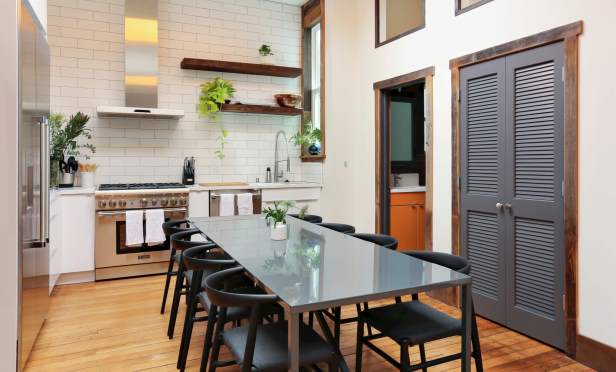
SAN FRANCISCO—More Americans–approximately a third of all households aged 22 to 35–live with roommates as they delay homeownership and marriage. At the same time, that group is still an underserved segment of the housing market.
The coliving company Common is changing that with a model that caters to young, mobile renters and a tech approach to property management. Since 2015, Common has launched 13 homes across New York City, the Bay Area, Chicago and Washington, DC with more on the way. It has the backing of New York City's most prominent real estate families–Milstein, LeFrak and Mack–who were lead investors in the $16 million Series B round.
Brad Hargreaves, founder and CEO of Common, recently discussed the concept of coliving, the reasoning behind it and the overall process in this exclusive.
GlobeSt.com: What is coliving and how did you first develop the concept for Common?
Hargreaves: Shared housing is not a new concept—people have been living with roommates forever. But now, people are living with roommates longer and later into their lives. Some do it out of economic necessity, while others seek the togetherness and community that living with others can provide.
The reality is that more than a quarter in urban centers ages 22 to 35 live with roommates. At the same time, people living with roommates are an underserved segment of the housing market. Big cities leave people without many decent or affordable housing options, but few developers and fewer property management companies think specifically about tapping into shared housing. When I co-founded the now-global education company General Assembly, I saw firsthand our instructors, employees and students struggling to find housing. They scoured Craigslist to find a room in a stranger's apartment, had to pay exorbitant fees to move in and then work through the dynamics of living in a shared space and splitting costs.
Common partners with real estate developers to design and operate homes designed for roommates. Our coliving suites come fully furnished with nightstands, lamps, fluffy pillows and comfy beds from Restoration Hardware and West Elm, and include shared supplies–all the basics roommates would need when moving into a new home, from paper products to cooking, laundry and cleaning supplies. Every Common home features free laundry. Once a week, the Common team cleans all shared spaces, including kitchens, living rooms and bathrooms.
GlobeSt.com: You have grown from one home in Brooklyn to operating in four markets in two years. What is the demand like for coliving?
Hargreaves: Today's renter is looking for convenience and community. The extreme demand we've seen for coliving has shown it's more than just a passing trend. Common has been rapidly expanding since we launched our first home in Brooklyn in 2015. We now have 13 homes across four markets, with an active and aggressive pipeline. We now receive more than 1,000 applications every week and more than 70% of Common members are on 12-month leases, with the vast majority of people staying longer than a year because they want to remain in the Common community.
GlobeSt.com: Common recently opened its third home in the Bay Area–what makes this area so attractive for coliving? How do you choose which markets to expand into?
Hargreaves: After launching in New York, we focused on expanding to the Bay Area and now have homes open in San Francisco and Oakland. We heard from our members in New York about the need for flexibility–if someone in Brooklyn gets a great job in San Francisco, he or she can now seamlessly move into a Common home there. This is critical for young, mobile renters. Common has expanded into Washington, DC and Chicago, and will continue growing in large urban centers with a need for better and more affordable living options.
GlobeSt.com: What's your process for working with developers to open a coliving home?
Hargreaves: Common works with developers, property owners and investors who see the need for shared housing tailored to the needs of the modern workforce. Common partners create community-minded homes that are affordable for the individual while also delivering above-market returns to our real estate partners. As a property manager, we take a home off a developer's hands and handle all aspects of leasing and management. We have worked on both ground-up new developments and gut renovations, and work closely with developers to create the best coliving projects with large, comfortable shared suites and ample community spaces.
GlobeSt.com: What makes Common different from its competitors?
Hargreaves: What sets us apart is our unique approach to innovation in operations, using data and technology, and building a strong brand and design aesthetic. We have an in-house team of architects and designers who create welcoming and comfortable shared spaces that foster a strong sense of community and convenience.
We have carefully built an innovative property management model that merges technology, design and real estate, and we have specifically tailored it to the unique needs of shared housing. We zero in on the operations to create a seamless living experience. Everything our members need–from the initial application to paying rent to requesting a repair–is done online. Every home comes with high-speed, commercial-grade WiFi included at no additional cost.
GlobeSt.com: How do you see the future of coliving evolving during the next five to 10 years?
Hargreaves: Coliving has a strong future and is driving innovation in the multifamily market. With strong demand for the product and nationwide expansion plans, coliving is how more people are choosing to live. The possibilities are endless in thinking about how coliving might serve families, seniors and many other populations well into the future.

SAN FRANCISCO—More Americans–approximately a third of all households aged 22 to 35–live with roommates as they delay homeownership and marriage. At the same time, that group is still an underserved segment of the housing market.
The coliving company Common is changing that with a model that caters to young, mobile renters and a tech approach to property management. Since 2015, Common has launched 13 homes across
Brad Hargreaves, founder and CEO of Common, recently discussed the concept of coliving, the reasoning behind it and the overall process in this exclusive.
GlobeSt.com: What is coliving and how did you first develop the concept for Common?
Hargreaves: Shared housing is not a new concept—people have been living with roommates forever. But now, people are living with roommates longer and later into their lives. Some do it out of economic necessity, while others seek the togetherness and community that living with others can provide.
The reality is that more than a quarter in urban centers ages 22 to 35 live with roommates. At the same time, people living with roommates are an underserved segment of the housing market. Big cities leave people without many decent or affordable housing options, but few developers and fewer property management companies think specifically about tapping into shared housing. When I co-founded the now-global education company General Assembly, I saw firsthand our instructors, employees and students struggling to find housing. They scoured Craigslist to find a room in a stranger's apartment, had to pay exorbitant fees to move in and then work through the dynamics of living in a shared space and splitting costs.
Common partners with real estate developers to design and operate homes designed for roommates. Our coliving suites come fully furnished with nightstands, lamps, fluffy pillows and comfy beds from Restoration Hardware and West Elm, and include shared supplies–all the basics roommates would need when moving into a new home, from paper products to cooking, laundry and cleaning supplies. Every Common home features free laundry. Once a week, the Common team cleans all shared spaces, including kitchens, living rooms and bathrooms.
GlobeSt.com: You have grown from one home in Brooklyn to operating in four markets in two years. What is the demand like for coliving?
Hargreaves: Today's renter is looking for convenience and community. The extreme demand we've seen for coliving has shown it's more than just a passing trend. Common has been rapidly expanding since we launched our first home in Brooklyn in 2015. We now have 13 homes across four markets, with an active and aggressive pipeline. We now receive more than 1,000 applications every week and more than 70% of Common members are on 12-month leases, with the vast majority of people staying longer than a year because they want to remain in the Common community.
GlobeSt.com: Common recently opened its third home in the Bay Area–what makes this area so attractive for coliving? How do you choose which markets to expand into?
Hargreaves: After launching in
GlobeSt.com: What's your process for working with developers to open a coliving home?
Hargreaves: Common works with developers, property owners and investors who see the need for shared housing tailored to the needs of the modern workforce. Common partners create community-minded homes that are affordable for the individual while also delivering above-market returns to our real estate partners. As a property manager, we take a home off a developer's hands and handle all aspects of leasing and management. We have worked on both ground-up new developments and gut renovations, and work closely with developers to create the best coliving projects with large, comfortable shared suites and ample community spaces.
GlobeSt.com: What makes Common different from its competitors?
Hargreaves: What sets us apart is our unique approach to innovation in operations, using data and technology, and building a strong brand and design aesthetic. We have an in-house team of architects and designers who create welcoming and comfortable shared spaces that foster a strong sense of community and convenience.
We have carefully built an innovative property management model that merges technology, design and real estate, and we have specifically tailored it to the unique needs of shared housing. We zero in on the operations to create a seamless living experience. Everything our members need–from the initial application to paying rent to requesting a repair–is done online. Every home comes with high-speed, commercial-grade WiFi included at no additional cost.
GlobeSt.com: How do you see the future of coliving evolving during the next five to 10 years?
Hargreaves: Coliving has a strong future and is driving innovation in the multifamily market. With strong demand for the product and nationwide expansion plans, coliving is how more people are choosing to live. The possibilities are endless in thinking about how coliving might serve families, seniors and many other populations well into the future.
© 2025 ALM Global, LLC, All Rights Reserved. Request academic re-use from www.copyright.com. All other uses, submit a request to [email protected]. For more information visit Asset & Logo Licensing.









